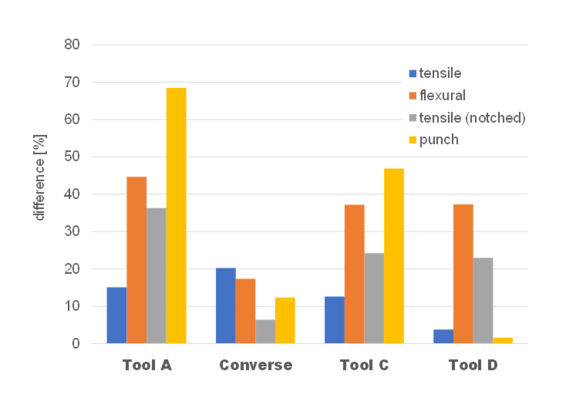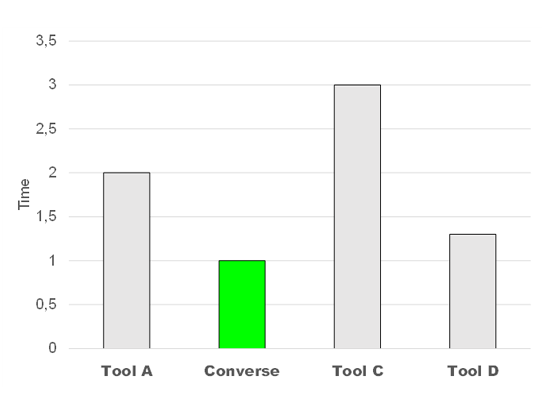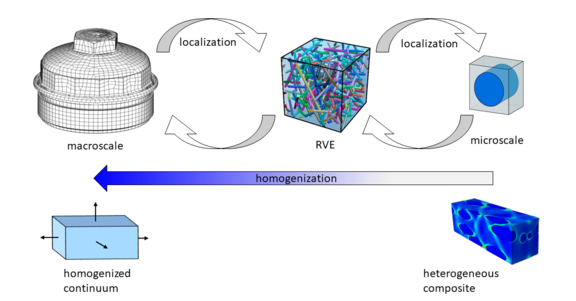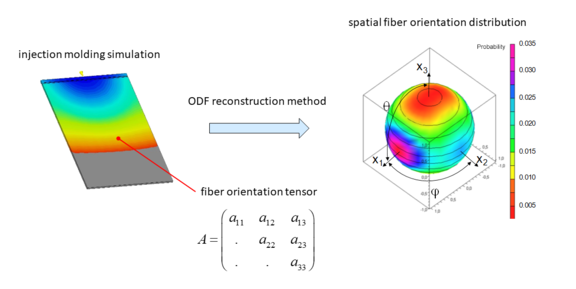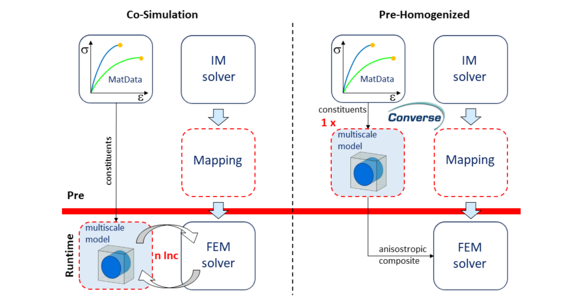An independent study evaluating commercial homogenization software [1] shows that Converse from PART Engineering has superior performance to competitors in terms of accuracy and computational speed. This paper first summarizes and comments on the results of the study. It then goes on to explain the key technologies implemented in Converse, that lead to this performance advantage. The study cited here is freely available, and can be accessed via the link in the bibliography at the end of this paper.
Study design
In the study [1], the four commercial homogenization software products or tools Converse, Digimat, material model PLY15 in PamCrash and a user subroutine from AsahiKasei were investigated. The corresponding references to the mentioned products are listed in the study. The investigations were carried out on injection-molded specimens or plates made of a PP+GF30. Different angles of the specimens with respect to the injection direction (0°, 30°, 90°) as well as different load types and specimen geometries (tension, unnotched and notched / bending, punch) were investigated. The respective material models were calibrated based on uniaxially measured material properties. Basis for all simulations were fiber orientations measured by micro-computer tomography (µ-CT). For all angular positions and load types, corresponding FEM simulations were performed with the different products and the obtained stress/strain or force/deformation curves were compared with the experimentally determined curves. The evaluation criteria were both technical and operational:
- accuracy of the representation of the experimental curve
- accuracy of the prediction of the onset of failure
- computing time
- usability
Study results
The comparison of the results obtained with the different products was carried out in the study in anonymous form (Tool A, Tool B, Tool C, Tool D). However, it can be deduced from the technological characteristics of the different products mentioned in the study that Tool B stands for Converse. This follows from the fact that the study states that only Tool B uses the full-Mori-Tanaka method for homogenization as well as the maximum-entropy method for reconstructing the orientation distribution from the orientation tensor. Already one of these two features allows an unambiguous identification. The identification of the other anonymized products is omitted here.
In summary, Figure 1 shows the relative deviation of the failure prediction to the test of the various products for all load types. Converse shows the lowest deviation in the majority of loading conditions and thus the best prediction quality.
Figure 2 shows a comparison of the computing times in normalized form. Converse has the lowest absolute computing time and is shown with the value 1 as a reference for normalization. The competing products achieved computing times in the range between 30 % and 200 % ! longer than Converse.
Superior technologies in Converse
In following an outline of the key technologies implemented in Converse is given that lead to the performance advantage outlined above.
Homogenization
Homogenization is a concept used in what is known as multiscale material modeling. A variety of different homogenization concepts exist. The aim of homogenization is always to describe the material behavior of an inhomogeneous material consisting of several components as a homogeneous continuum. This allows a numerically efficient treatment of the material in the simulation. Ideally, the mathematically homogenized material should have identical mechanical properties (e.g. anisotropy) as the physically inhomogeneous material (Figure 3). The extent to which this is achieved also depends on the homogenization concept chosen, since the description quality of the various homogenization concepts differs. Converse is the only one of the products investigated in the study to use the full-Mori-Tanaka approach, while all other products use the so-called pseudo-grain approach. In contrast to the pseudo-grain method, the full Mori-Tanaka method also takes into account the interaction between the different fibers in the matrix during homogenization, since the matrix is regarded as a continuum. This thus corresponds more to the physical situation in the material. The differences between the methods and the theoretical background are discussed in the study.
Reconstruction of the orientation distribution
A prerequisite for describing the anisotropic material behavior of short fiber reinforced plastics is knowledge of the local fiber orientation. The local orientation state is usually described in terms of the orientation tensor. The orientation tensor can be obtained either experimentally, as in the study via µCT measurements, or via an injection molding simulation. In the context of homogenization, however, the fiber orientation distribution (ODF orientation distribution function) is required. The orientation tensor therefore only indirectly provides information about the ODF, which must be calculated from the orientation tensor (Figure 4).
One problem is that the orientation tensor does not describe the ODF uniquely. Different ODFs can be represented by the same orientation tensor. Usually for the computation of the ODF from the known 2nd order orientation tensor a 4th order orientation tensor is needed. This cannot be derived analytically therefore usually so-called closures are used. Such an approach is used in the competing products. In Converse, on the other hand, a maximum entropy method is used which works without such a closure. The maximum entropy method usually leads to a good reconstruction of the underlying ODF, details are given in [2].
Plasticity and failure modeling
According to the study, Tool A and Tool C use failure criteria defined at the pseudo-grain level. In Converse and Tool D, on the other hand, failure is considered macroscopically. In particular, a hybrid material modeling approach is used in Converse. The linear behavior of the material is described using the multiscale model presented above. The plastic behavior is modeled on the basis of a modified Hill yield surface. This allows a numerically extremely efficient handling of the nonlinear plastic material behavior while at the same time providing a good representation of the failure behavior even for multi-axial loading conditions, as the study shows. Failure criteria defined at the pseudo-grain level obviously do not offer any advantages here, while at the same time requiring significantly more numerical effort.
Technological implementation
The technology of pre-homogenized material cards, originally developed by PART Engineering, allows the use of solver-built-in material models. In this sense, Converse is "only" used to calculate all required material model parameters once in pre-processing and to export them for the material models available in the respective FEM solver. User subroutines or a co-simulation by means of an external material model at runtime of the simulation are thus not required (Figure 5). This enables a numerically extremely efficient simulation, as also proven by the study on the basis of the computation times (Figure 2). Furthermore, the full functionality available within the respective solver is thus available, such as multiprocessor capability. Another advantage is that no license is drawn for Converse during the runtime of the simulation, since Converse is only needed to create the material cards. The fact that Converse exports the entire anisotropic material behavior in the form of human readable material cards means that the material cards can be easily passed on to co-workers and customers. In terms of quality assurance and documentation of the simulation carried out, the concept offers considerable advantages, as the data can also be accessed in the long term, even if a Converse license is no longer available.
Conclusion
The study proves that the complexity of the implemented material models is neither a measure for practicality nor for result accuracy. Rather, the opposite is proven: With Converse, good prediction quality and short computation times can be achieved simultaneously. Converse's open data handling concept allows easy technical and organizational integration into existing CAE work-flows and software infrastructure. The database delivered with Converse already contains pre-calibrated material models for many commercial plastic grades, and interfaces to well-known FEM software exist.
Converse thus offers an easy-to-use approach to advanced simulation of plastics that can be handled even by occasional users and non-materials experts. This is in agreement with our claim to offer practice-oriented software that delivers fast, robust and reliable results in daily work.
[1] Veltmaat, L.*; Endres, H.J.**; Bittner, F.**: Evaluation methodology of commercially available homogenization software for the optimized simulation of the mechanical behavior of short fiber reinforced plastics. Zeitschrift Kunststofftechnik 17(2021)3, S. 129-151, *Volkswagen AG, **Institut für Kunststoff- und Kreislaufwirtschaft, Leibniz Universität Hannover
[2] Breuer, K.; Stommel, M.; Korte, W.: Analysis and Evaluation of Fiber Orientation Reconstruction Methods. J. Compos. Sci.2019, 3(3), 67, https://doi.org/10.3390/jcs3030067
Author
Dr. Wolfgang Korte, Managing Director, PART Engineering GmbH, Bergisch Gladbach, Germany
